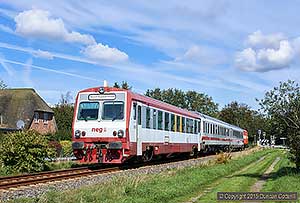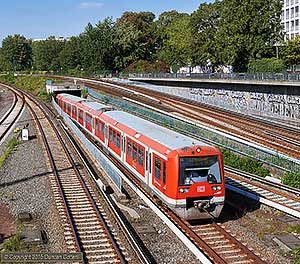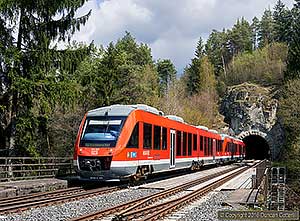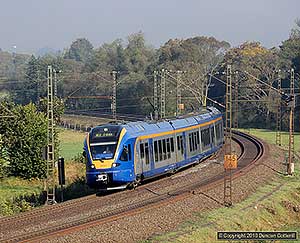Class 403, 406 - 408
2 photos
updated : 2022-09-03
Class 403 was introduced in 2000 as the first of a new generation of high-speed trains, known by DB as ICE3, primarily for use on services routed via the new Köln - Frankfurt NBS. While the 403 is 15kV AC only, classes 406 - 408 are also equipped to operate in Netherlands, Belgium and France.
Class 612
44 photos
updated : 2022-09-02
The Class 612 2-car tilting DMU is a development of the Class 611 and around 190 are in traffic with DB Regio. The units see widespread use on Regio-Express services on unwired secondary main lines, particularly in Bayern and Sachsen, but seem to be less common elsewhere in Germany.
Class 628, 629
28 photos
updated : 2022-09-01
The class 628 2-car DMU was introduced in 1974 as a prototype but it was over a decade before a much modified version went into series production in 1987. Over 400 units of classes 628.2 and 628.4 were built over the next decade and they can be found on local services all over Germany.
Class 610
21 photos
updated : 2022-09-01
The 20 2-car units of class 610 were introduced in 1992 and were DB's first tilting DMUs They spent their lives on the diesel worked lines north-east of Nürnberg where they clocked up an average of around 5 million km each before being withdrawn as non-standard at the end of 2014.
Class 411, 415
7 photos
updated : 2022-08-29
Tilting 7-car Class 411 and 5-car Class 415 ICEs are used on routes with severe curvature on some sections that would also benefit from high speed running. In appearance the 411s and 415s are very similar to the very high speed non-tilting ICE3 (class 403) but have a less pointy nose and are limited to 230km/h.
Class 626, 627
1 photo
updated : 2022-08-27
Classes 626 and 627 cover various types of single-unit bogie railcars used by DB and other operators on the German system since the 1970s. These include prototype units, those built to the same design as the ÖBB Class 5047 and the NE81 design favoured by a number of private railways.
Class 605
2 photos
updated : 2022-08-25
The 20 Class 605 4-car high-speed DEMUs were an attempt to produce ICE trains for use on unelectrified lines. The 605 had many components in common with the electric ICE-T sets but were unreliable and expensive to operate. Several were hired to DSB for services to Germany until 2017.
Class 424, 425, 426
10 photos
updated : 2017-05-28
The 4-car Class 424 and 425 and 2-car Class 426 15kV AC articulated EMUs were introduced by DB in 1998-9 for regional services and can be found in many parts of Germany. Class 424 are identical to Class 425 apart from having retractable steps for use at stations with lower platforms.
Class 611
8 photos
updated : 2017-05-28
DB's 2-car class 611 tilting DMUs were meant to be an all-German equivalent of the Class 610 units. Introduced in 1996, they had numerous problems and were withdrawn in 2018. All 50 sets were based at Ulm and used on RE and RB services on non-electrified routes in Baden-Württemberg.
Class 440
7 photos
updated : 2017-03-16
Alstom's Coradia Continental articulated EMUs are Class 440 in the German numbering system and operated by DB and a number of independents including NordWestBahn and Agilis. The first 440s were built in 2008 and 3, 4 and 5 car sets have been produced to date at Alstom's Salzgitter plant.
Class 650
9 photos
updated : 2017-03-16
The Class 650 single unit was introduced in 1996 and produced by ADtranz at the former DWM plant in Berlin. In 2001 the factory was sold to Stadler and production continued under their auspices. The 650s are popular in Germany, with DB and the independent sector operating over 450 units.
Class 472, 474
6 photos
updated : 2016-07-05
Hamburg's S-Bahn is a bit more interesting than most as it's electrified at 1200V DC with bottom-contact third-rail. The system has its own dedicated fleet of 3-car EMUs of different designs to the usual S-Bahn fare. In 2015 Class 474s operated most services but the older Class 472s were still quite common.
Class 648
6 photos
updated : 2016-06-02
The class 648 is a lightweight articulated 2-car unit, designed by Linke-Hofmann-Busch but now built by Alsthom as the Coradia LINT 41. Class 648 DMUs are in widespread use with DB and independent operators and can be found in many parts of Germany on branch line and main line stopping services.
Class 642
5 photos
updated : 2016-01-27
The class 642 is a lightweight articulated 2-car DMU from the Siemens Desiro range. DB have over 230 and they're also popular with independent operators. Although designed for lightly trafficked branch lines, they seem equally at home on main line stopping services and can be found in many parts of Germany.
Class 426 - 430
6 photos
updated : 2016-01-27
Classes 427 to 430 are the three to six car versions, respectively, of the Stadler Flirt articulated EMU design and have proven popular in Germany with over 450 units in service with DB and independent regional operators. More Flirts are on order for Germany, including a battery-electric version.
Class 401, 402
7 photos
updated : 2015-10-30
Class 401 units were introduced in 1989 and were the original ICE high speed EMUs, capable of 280km/h and usually formed of two power cars and 12 trailers. Class 402 followed a few years later with a single power car, 6 trailers and a driving trailer. Both classes are still in front-line service.
Germany has one of the largest and busiest railway systems in Europe with most important routes electrified. There's plenty of freight traffic on the main routes and frequent passenger trains on most lines. Add some attractive scenery and a wide variety of liveries and you have an excellent place to photograph trains




 options
options hide options panel
hide options panel


















